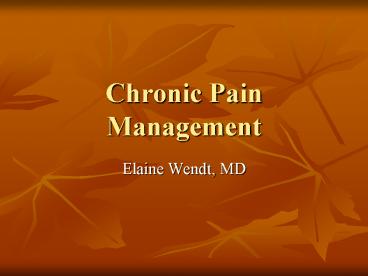Chronic Pain Management - PowerPoint PPT Presentation
1 / 21
Title:
Chronic Pain Management
Description:
Chronic Pain Management ... including risk of Addictive Disorders Depression Anxiety Substance ... Activity Adverse effects Aberrant behavior Document all ... – PowerPoint PPT presentation
Number of Views:153
Avg rating:3.0/5.0
Title: Chronic Pain Management
1
Chronic Pain Management
- Elaine Wendt, MD
2
Pain is now Fifth Vital Sign
3
- The best way to perceive the professional burden
involved in the care of patients with chronic
pain is to pick your most comfortable chronic
medical diagnosis to manage and take out that
diagnosis and substitute the syndrome, chronic
pain.
4
For Example
- My patient with diabetes will have diabetes
throughout her lifetime and need medical help to
manage the diabetes throughout her lifetime while
I am her physician. - My patient with chronic pain will have chronic
pain throughout her lifetime and need medical
help to manage the chronic pain throughout her
lifetime while I am her physician.
5
Pain management physiologic permanence
- http//www.ama-assn.org/ama/no-index/about-ama/164
08.shtml - Somatic pain model
- Local inflammationgtlowered threshold of c-fiber
excitationgt eventual Rexed lamina 5 wide dynamic
neuronal intracellular protein changes. - Neuropathic pain model
- Nerve injurygt changes in location, density,
number, and type of ion channelsgt altered nerve
firinggt eventual Rexed lamina 5 wide dynamic
neuronal intracellular protein changes gt altered
neurotransmitter dynamicsgt neuronal death/drop
outgt altered behavior of glial and other
architectural cells (scar)
6
Currently no single pain medication exists that
will take away more than 30 of a patients
chronic pain.
7
Set Appropriate Expectations Early
8
Assess Pain Score and Functionality
- Wong Baker in EMR
- ICSI Functional Ability Questionnaire
9
Make an Appropriate Differential Diagnosis
- Determine biological mechanisms of pain
- Neuropathic pain
- Muscle pain
- Inflammatory pain
- Mechanical / Compressive pain
10
Identify and Address Comorbitities Early On
11
Perform a Psychological Assessment, including
risk of Addictive Disorders
- Depression
- Anxiety
- Substance Abuse and Dependence
- Sleep disorders
- Personality disorders
- History of abuse
- Coping patterns and resources
- Spirituality
- Working and disability Issues
12
Make Therapy GOAL Oriented, Not PAIN Oriented
- By Next visit, I will be able to do
13
Use a Treatment Agreement
- Plan of care
- Set personal goals
- Improve sleep
- Increase physical activity
- Manage stress
- Decrease pain
14
Use of Controlled Substances is Sometimes
Appropriate. However, there are Associated Risks.
15
DEA Practitioners manual
- The Drug Enforcement Administration is pleased
to provide this updated edition of the 1990
Practitioners Manual to assist you in
understanding your responsibilities under the
Controlled Substances Act (CSA) and its
implementing regulations. This manual will help
answer questions that you may encounter in your
practice and provide guidance in complying with
federal requirements. - DEA remains committed to the 2001 Balanced Policy
of promoting pain relief and preventing abuse of
pain medications. In enforcing the CSA, it is
DEAs responsibility to ensure drugs are not
diverted for illicit purposes. Unfortunately,
this country is now experiencing an alarming
prescription drug abuse problem - Today, more than 6 million Americans are abusing
prescription drugsthat is more than the number
of Americans abusing cocaine, heroin,
hallucinogens, and inhalants, combined. - Researchers from the Centers for Disease Control
and Prevention report that opioid prescription
painkillers now cause more drug overdose deaths
than cocaine and heroin combined. - Today more new drug users have begun abusing pain
relievers (2.4 million) than marijuana (2.1
million) or cocaine (1.0 million). - It is more important now than ever to be vigilant
in preventing the diversion and abuse of
controlled substances. This manual will help you
do that by listing some safeguards you can take
to prevent such diversion. It also explains
registration, recordkeeping, and valid
prescription requirements. - As a practitioner, your role in the proper
prescribing, administering, and dispensing of
controlled substances is critical to patients
health and to safeguarding society against the
diversion of controlled substances. DEA is
committed to working jointly with the medical
community to ensure that those in need are cared
for and that legitimate controlled substances are
not being diverted for illegal use.
16
Document Informed Consent
- Informed consent for chronic opioid therapy (HCHD
has bilingual forms) - Side effects of medication
- Monitoring of medication use
- Refill policy
17
Assess Pain Level and Function before and during
Therapy
- Wong Baker Scores
- Attainment of Goals
18
Regularly Assess the 4 As
- Analgesia
- Activity
- Adverse effects
- Aberrant behavior
19
Document all Assessments and Care Plans
- Texas Medical Board Rules, Ch.170
- http//www.tmb.state.tx.us/rules/docs/CurrentRules
Revised09-20-07.pdf
20
Texas Medical Board Rules, Ch.170
- The Shalls
- the medical record shall document the medical
history and a physical examination that includes
a problem-focused exam specific to the chief
presenting complaint of the patient. - The medical record shall document the
physicians rationale for the treatment plan and
the prescription of drugs for the chief complaint
of chronic pain and show that the physician has
followed these guidelines - Each periodic review shall be documented in the
medical record
21
Summary
- Chronic pain is a chronic illness
- Assess comorbidities early on
- Create goals for therapy
- Use formal contracts for controlled substances
- Reassess and document































